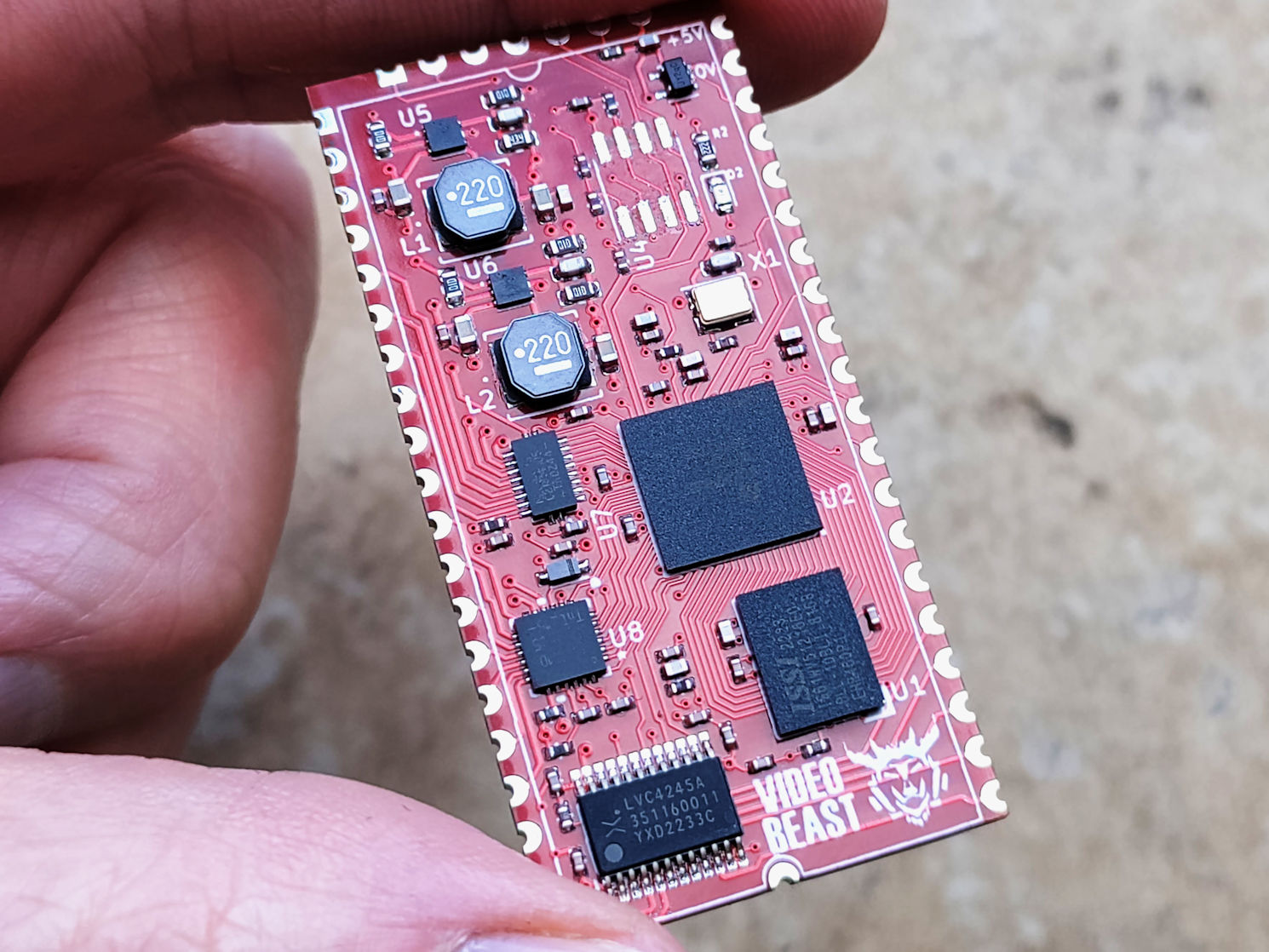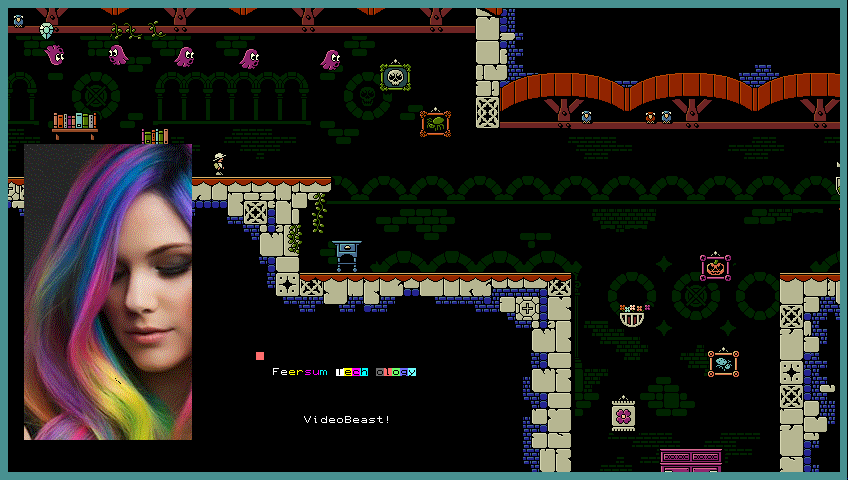VideoBeast

TLDR;
All-new best in class graphics chip for 8-bit computers
- Arcade level 2D graphics
- Resolutions from 320x240 to 848x480
- 1MB (Megabyte!) video RAM
- 512 colours, 6 layers: text, bitmap, tiles
- Up to 256 sprites, sized 8x8 to 32x32
- Raster effects, line interrupt, hardware scroll
- Host adaptors for: MicroBeast, ZXSpectrum, RC2014
- SD Card interface
..and more!

Detailed Specifications
Click for full documentation. Note that specs are still subject to change.
- Supported resolutions: 640 x 480, 320 x 240 (4:3) and 848 x 480, 424 x 240 (16:9)
- Colours: 3:3:3 RGB (512 colours, 9 bit)
- Palettes: 1 x 256 colour palette. 16 x 16 colour palettes.
- Video RAM: 1 Megabyte. Memory mapped with direct (paged) CPU access.
- Screen layout: 6 independently positioned layers of any type (text, bitmap, tile, sprites)
- Text layers: 128 x 64 characters, 16 colour foreground/background attribute per character. Software font.
- Bitmap layers:
- 1-bit 1024 x 512, 16 colour foreground/background attribute per 8x8 cell.
- 4-bit 1024 x 512, 16 colour per pixel.
- 8-bit 512 x 512, 256 colour per pixel.
- Sinclair screen layout supported.
- Tile layers: 128 x 64 cells, each 8x8 pixel from 1024 tiles, palette per tile.
- Sprite layers: Up to 256 sprites, 8/16/24/32 pixel width & height. Mirror, flip, grouping. Up to 1024 unique graphics.
- All graphics data, fonts, sprite lists, tile and text maps independently positionable in video RAM (per layer).
- SPI interface (SD Card and 1.5Mb onboard flash) including 3Mb/sec DMA transfer to/from video RAM.
- Programmable line interrupt. Double buffering. Raster effects.
- Fast 16x16 (32 bit result) integer multiply unit.
- Video output: 9bit digital. Converts to VGA with resistor ladder. DVI adaptors should work (untested).
- Power: 5v.
FAQs - Spring 2025
Which 8-bit Computers?
There are host interfaces for ZX Spectrum, RC2014 and, of course, MicroBeast - but VideoBeast is designed to interface with any 8-bit CPU, so it should be possible to upgrade your original computer, modern retro machine or homebrew project to have stunning graphics and a high resolution text console. If you can add additional RAM to your system, you should be able to use VideoBeast.
Project Status
It has been important to get VideoBeast right, and over the last year that meant a lot of background work to make sure all features worked flawlessly together - from a redesigned sprite system to fast DMA transfers from SD-Cards. It's been... a journey.
But we're almost there.
We've demonstrated fast maths, a new host adapter for the ZX Spectrum, an improved SPI system and there are a couple of announcements still to make. Very soon there will be a limited number of dev boards available on a waiting list, and beyond that an official launch. Exciting, isn't it?
Development Tools
As work on VideoBeast progresses, development tools and documentation are being added. Check out the preliminary reference documentation for information on coding for VideoBeast. The BeastEm MicroBeast Emulator now emulates VideoBeast, so it's possible to try out real code with the latest hardware API. And if you need help converting graphics to run on the system, the Feersum Image Utils web page provides a browser tool for palette manipulation and image scaling.
How does it work?
For the host computer, it couldn't be simpler. VideoBeast is wired like a standard 4, 8 or 16K RAM chip. Provide 5 volts, address and data lines, and three control signals (chip select, write enable, output enable) and all control over VideoBeast is through normal memory reads and writes. A programmable interrupt can be used to synchronise the host with the display output. Then, video output is digital, which can be converted to a VGA signal through a simple resistor network.
Interface - 1MB RAM on an 8-bit Host?!
VideoBeast presents paged memory and control registers to the host system as a contiguous addressable memory space. This allows the host to directly write text, tiles, bitmaps, sprites and configuration data to the device at full speed with no contention. On reset, a text layer is paged in - console output from the host is as simple as writing a byte to memory.
Hardware
The hardware comprises a custom FPGA board with power, interface logic and RAM in a minimal footprint. Physically, it has 0.1" castellated solder pads and a flat underside for solder-down installation.
How does it compare to <x>?
The hardware was designed as a direct response to the limitations of many current solutions - so of course I think it's better than anything else! It's not really though - if you want higher resolution or photographic quality, 3D texture mapping and video then go and buy a Raspberry Pi.
However for an 8-bit host, VideoBeast is designed with a deep understanding of the techniques and tricks that built legendary video games... plus a healthy dose of raw power. Microcontroller hacks don't stand a chance. Memory size and bandwidth is king, and a well designed interface makes it possible to get the most out of the system. There really is nothing quite like VideoBeast.
Shut up and take my money! When can I have one?
No, and not yet. Once the firmware is stable, early units will be available to MicroBeast owners. Depending on interest (and final performance details), a bigger run will follow. Final pricing will be dependent on production size, since this is a complex board requiring accurate manufacture and testing.The VideoBeast Project
Building an 8-bit computer or upgrading an existing retro machine consistently comes up against one problem - video is hard. Microcontrollers like the Pico or ESP32 provide quick solutions that hide serious limitations. Insufficient internal video ram, devices running at or beyond their limits, hacks for each different display arrangement and restricted bandwidth to the host computer are all common issues.
Such systems are also difficult to program on. Timing is unpredictable, the display state is opaque and functions are often limited to the precise use case the firmware was designed for. It's not surprising many developers miss the purity of classic video display processors.
VideoBeast is intended to provide that purity. It behaves like an old-school memory mapped display whilst providing the powerful compositing features of 2D arcade boards, 1 megabyte of video ram and modern display resolutions. It interfaces directly with standard 5 volt, 8 bit busses and outputs digital video that can easily translated to a VGA signal, with an eye on supporting other output formats later on. As a bonus, it also incorporates an SD-Card interface, handling all of the voltage translation for the host system.
Whilst VideoBeast was always planned as an expansion for MicroBeast, the interface is host agnostic - VideoBeast should work with any system that can write to 4,8 or 16K static RAM chips. It imposes no timing restrictions on the host computer, other than an estimated 70ns access time.
Most importantly, the hardware is designed to be simple to program yet deliver usable power for 8-bit systems. This is not about absolute resolution or colour depth - both of which can overwhelm host processors. Instead, multiple independent text, tile, bitmap and sprite layers can be manipulated through a small register set. The large video RAM means that a thousand sprite patterns, or four thousand tiles can be pre-loaded, as well as four software fonts and a number of full-screen bitmaps. These can then be efficiently positioned on screen with all the conveniences of transparency, double buffering, raster effects and scan-line interrupts.
VideoBeast is designed to recreate the power of a discrete logic video card, but in a tiny form factor and at a fraction of the cost.